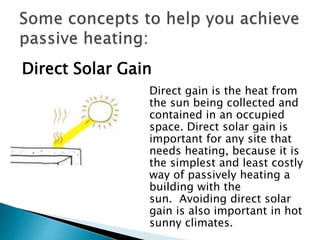Passive Heating
- 2. Passive heating : -refers to technologies or design features used to heat buildings without power consumption. -building design attempts to integrate the principles of physics into building exterior envelope to: *speed up heat transfer into a building
- 4. ï― Aperture- the large glass area, usually a window, through which sunlight enters the building. Typically, the aperture faces within 30 degrees of true south and should avoid being shaded by other buildings or trees between 9 a.m. to 3 p.m. each day during the heating session ï― Absorber- a hard, darkened surface of the storage element, is the second element of the design. The surface sits in the direct path of the sunlight, which hits the surface and is absorbed as heat ï― Thermal mass-the materials that retain or store the heat produced by the sunlight. Unlike the absorber, which is in the direct path of the sunlight, the thermal mass is the material below or behind the absorberâs surface
- 5. ï― Distribution- the method by which solar heat circulates from the collection and storage points to the different areas of the house ï― Control- During the summer months, roof overhangs are used to shad the aperture. Other elements can be used to control the under- and/or overheating include electronic sensing devices, operable vents and dampers, low-emissivity blinds, and awnings.
- 6. Direct Solar Gain Direct gain is the heat from the sun being collected and contained in an occupied space. Direct solar gain is important for any site that needs heating, because it is the simplest and least costly way of passively heating a building with the sun. Avoiding direct solar gain is also important in hot sunny climates.
- 7. Massing and orientation are important design factors to consider for passive heating. Consider these factors early in the design so that the surface areas exposed to sun at different times of day, building dimensions, and building orientation can all be optimized for passive comfort.
- 8. Thermal mass is a material's resistance to change in temperature. Objects with high thermal mass absorb and retain heat. Thermal mass is crucial to good passive solar heating design, especially in locations that have large swings of temperature from day to night.
- 9. ï― A Trombe wall is a system for indirect solar heat gain that is a good example of thermal mass, solar gain, and glazing properties used together to achieve human comfort goals passively. It consists of a dark colored wall of high thermal mass facing the sun, with glazing spaced in front to leave a small air space.
- 10. ï― Windows and other apertures bring in heat from sunshine, but can also lose heat by radiant cooling and by conducting heat better than most wall or roof constructions. Apertur es and shading must be intelligently placed to take advantage of the sun's heat in cold locations and seasons, while not overheating in hot seasons.
- 11. ï― Shades can keep the heat and glare of direct sun from coming through windows. They can also keep direct sunlight off of walls or roofs, to reduce cooling loads.











